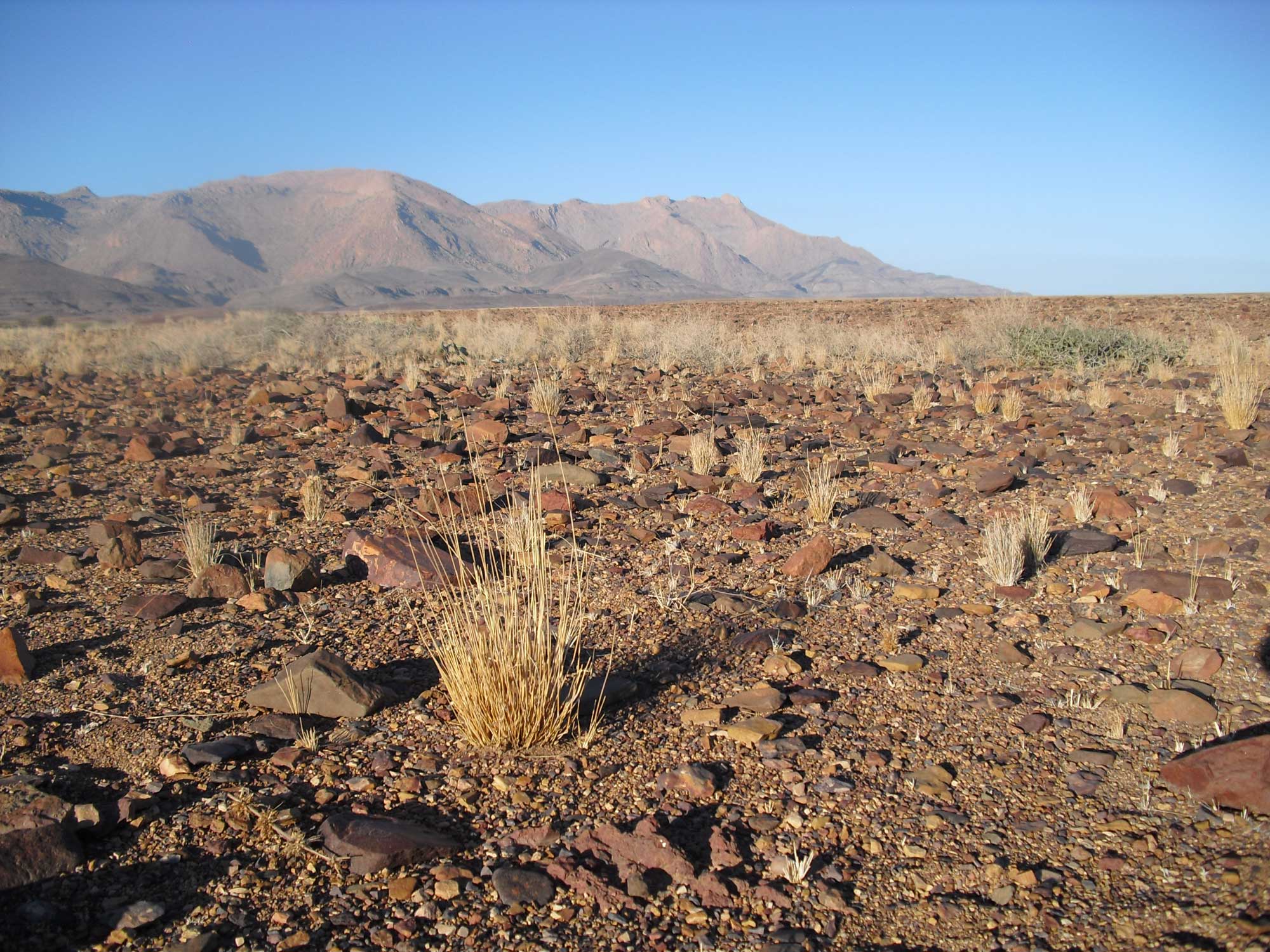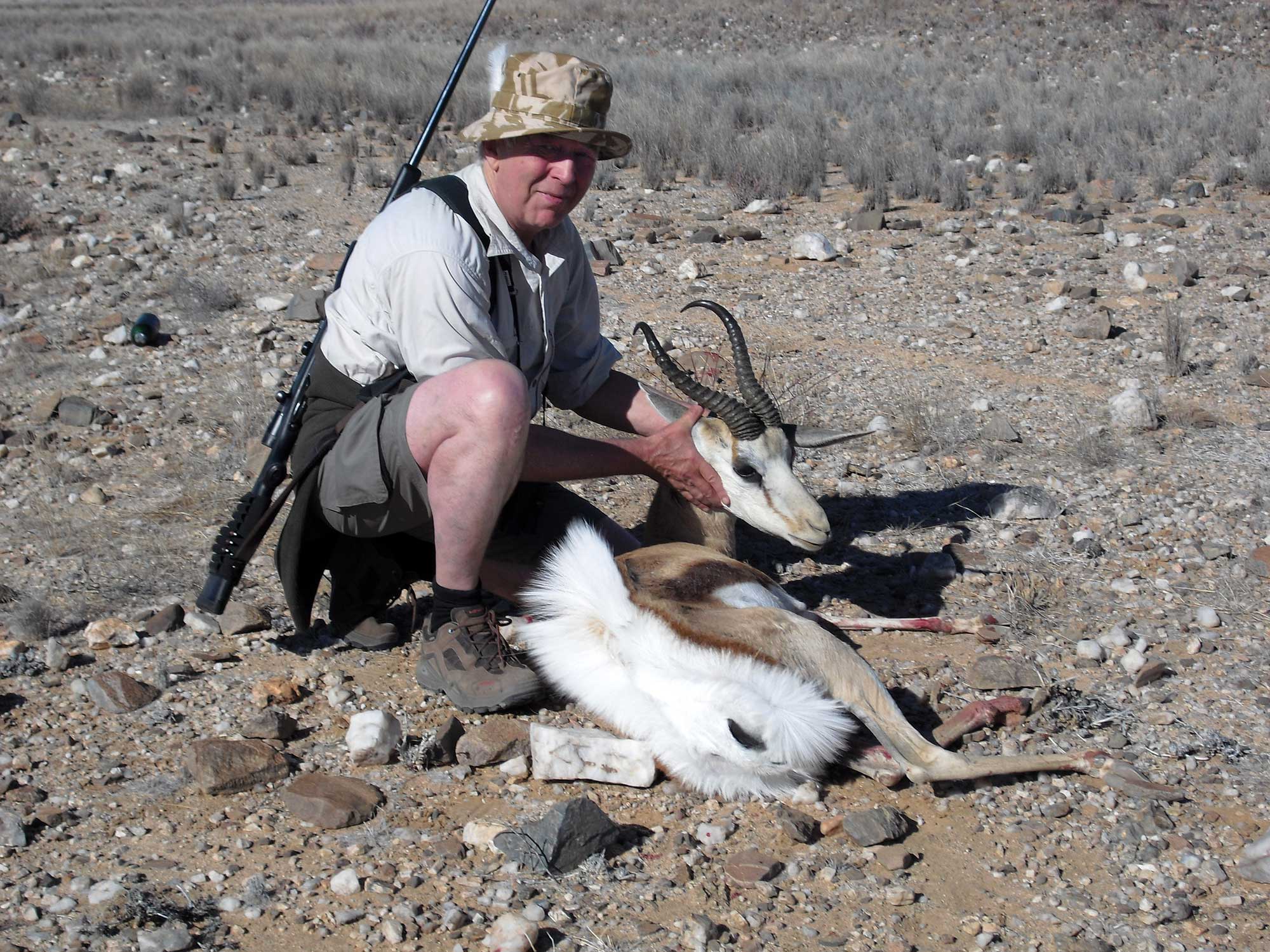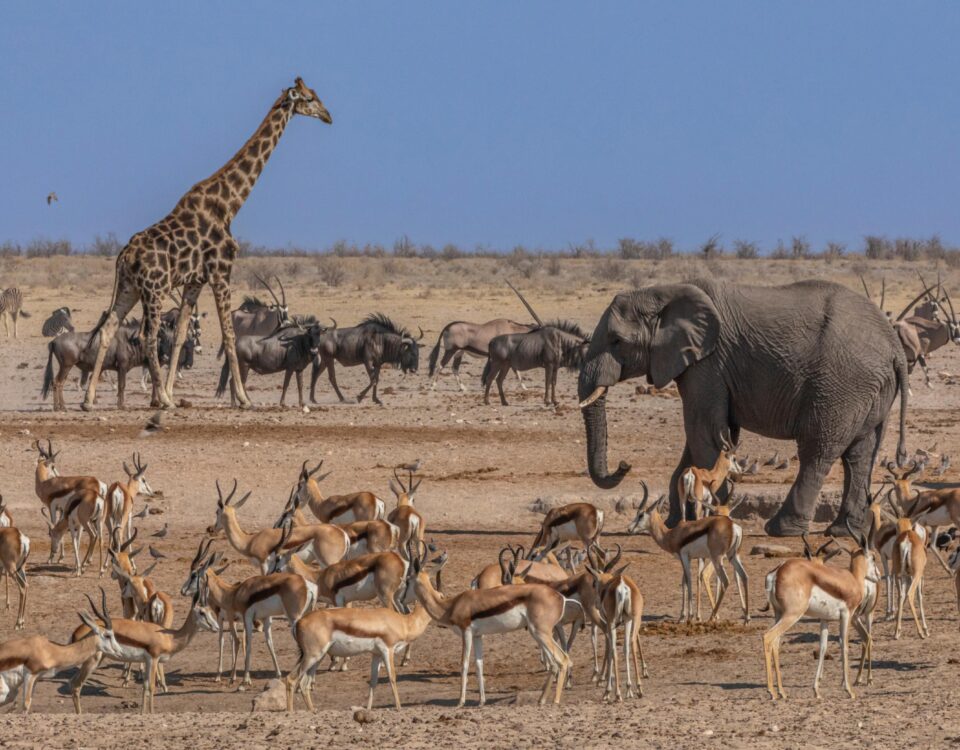| Main photo ©Paul van Schalkwyk

Lucky 13 – Elephant hunt
June 13, 2016
The king of the dry bushveld and the rugged hills
June 14, 2016T he endless gravel plains reflect the cold, bluish moonlight. It’s freezing and we’re glad that Hagen and his helpers from the Tsiseb Conservancy pitched our tents and prepared the camp the previous day. Stew is bubbling in the cast-iron pot on the red coals. We sit around the fire celebrating a long day, each downing a can of beer.
All in all, I’ve been travelling for 30 hours and have covered almost 7 000 miles. To do this I raided my bank account, an effort surpassed only by my hunting friend Kai-Uwe Denker. He, with his son, Hagen and four Damara assistants, prepared the camp. This was also an arduous task, as it involved driving two Land Rovers over hundreds of miles, loaded with tents, a water tank and other provisions.
What an undertaking! Just to hunt a big territorial antelope – or maybe two – here in the middle of nowhere. Yes, it’s insane! My friends’ comments were: “Springbok in Namibia?” “What are you really going to hunt?” “What is your main objective?” and “A springbok safari? That‘s a bit weird, isn‘t it?” I guess these were justifiable questions.
After all, Antidorcas marsupialis are common throughout Namibia. They can be found leaping around even close to the main airport. You can enjoy hassle-free springbok hunts with all the comforts, including accommodation in luxury bungalows complete with pool and wine cellar, or from exclusive camps with a laundry service and electricity. For trophy fees ranging from US$200 to US$500, the springbok is an attractive trophy to take along.
But not for me. I am looking for the real experience, the core of hunting. All my senses are centered on the old territorial ram that has struggled and survived in a harsh environment. Since touching the spectacular trophies from Damaraland on Kai-Uwe’s isolated farm, I’ve been looking forward to being in this tent under the camel-thorn tree.
Stalk in the desert
The last stars are fading as we sip our morning coffee around the fire. A rusk goes down with the coffee. This will just have to do for our first sortie into the vast land. During the night, pallid patches of fog have crept in from the Atlantic Ocean. Now dewdrops are blinking from thorns, branches, bushes and grass. It is because of this moisture that springbok survive in the inhospitable semi-desert areas. I picture them picking their juicy breakfast from stems, somewhere in the dry valleys.
We set out. The hard, crystalline ground makes walking a delight. As the sun rises, millions of white quartz pebbles flash up brightly. The majestic Brandberg spreads blue shadows like carpets among its foothills. The silence is absolute, except for the calls of Ludwig’s bustards and the pebbles knocking against each other under our boots. Here a bat-eared fox wanders around on his morning prowl, as we are; there lie the bleached bones of an ostrich, possibly the prey of a cheetah. We see giraffe tracks in a dry riverbed, the tiny nests of Gray’s larks under sparse grass tufts. This is indeed a living desert.
After a few miles we spot the first springbok. A group of eight is climbing up a distant ridge. They move on without faltering. Over the next few hours we see several groups, all of them far away. Finally, we spot a ram that looks worthwhile. We check the wind and move forward, approaching it in a wide arc. My pulse rate goes up, I slip a round into the chamber. Rapidly we close in to about 400 yards. Kai-Uwe comments laconically: “It’s in its prime, but it’s not what we’re looking for.”
Later, from a low hill, we glass the bed of a dry river tributary. As vast and forlorn as the landscape might appear, there is always something to discover. A kori bustard, a gemsbok, two martial eagles – small, but clearly visible in the pure desert sky. At the tip of my boot I discover a black arrowhead. I pick it up and think of the hunter who was looking for game here, exactly here, where we are standing now. Like the ram that emerges right now from behind a bush far down in the riverbed. I focus on that distant target, keen to take up the chase. I want to outsmart him, walk all day, if necessary! But my guide is still relaxed. The steep angle of the horns and the animal’s somewhat edgy movements reveal that he is still a youngster.
Horned visions
Every day we patrol some 10 to 15 miles through a minimalist landscape. It undulates almost imperceptibly, with flat depressions and shallow ditches. There are no juicy green leaves or colourful blossoms to be found here. However, the longer we wander through the semi-desert, the more beautiful its delicate and subtle colours become.
We regularly see springbok, check their trophies, size, behaviour and movement. We see them flit by in the searing heat at least 80 to 100 times, the white of their bellies blending with the sand, their graceful bodies, ochre-coloured over the black flank stripe, seemingly hovering above the ground. With the binoculars we spot a ruminating ram resting in the shade of a bush. Herds of ewes feed against the backdrop of the mighty Brandberg, every now and then accompanied by a bachelor. There are quite a few times that I could have taken a shot, but the right one was never among them. Do you have to be wacky to simply enjoy every second of such a pure hunt?
The perfect one
One morning we stalk in a hilly area with many gullies and dales. It is easy to traverse, but the game is very much on the alert, with cheetahs and leopards also looking for an opportunity. Cautiously we proceed over the rocky slopes, avoiding the crests and checking the surroundings. Suddenly we’re treated to an electrifying sight. Three females are moving through a hollow in a northerly direction, followed by a big ram.
“I am looking for the real experience, the core of hunting. All my senses are centered on the old territorial ram that has struggled and survived in a harsh environment.”

Making a brief hand signal, Kai-Uwe instructs me to take cover. This is the one! On our bellies we retreat backwards until we’re out of sight. Then we start running to cut off their path. While on the move, I chamber a round. Soon we’ve passed the hill. Fifty yards ahead we see a knee-high rock. It’s the ideal rifle rest. Crouching low and without making a sound, we draw closer. Then, after a few steps, Kai-Uwe freezes, and in slow motion sits down on the ground. Behind him, I slowly slide closer and put the Winchester on his shoulder, not a second too soon.
The three springbok ewes appear over the crest. They are 160 yards away and have noticed us. The oldest one, a smallish matron with long, thin horns, is already very nervous. They will not stay for long. But, damn, where is the ram? Then his horn tips appear behind the rubble. He’s somewhat off-centre, impossible to shoot from this angle.
Cautiously I skirt around Kai-Uwe to gain a better angle. The ram, unbearably slowly, edges forward. Now his head and horns are visible. But I don‘t even look at the horns. We are totally focussed on the moment when the ram stands free. In the blink of an eye I almost unconsciously realise that the smart old ewe knows what’s going on. She stretches her neck even longer, her head moving slightly to the side, her eyes directed straight at us. She will take off any second now. In an unbelievable contrast to this drama, the ram emerges calmly into the open. At this point, I become completely calm. An intense concentration sets in. The three ewes turn away, ready to flee the scene. The ram stands free. A split second, half a breath, my finger easy on the trigger. At the report of the gun, the ewes take off, weightless through the sky. Spectacular leaps, as if bouncing in slow motion. Springbok writing their names in the air…
The ram is down. A magnificent monarch in his desert kingdom. The strong, finely chiselled horns speak of age, power and battle. They are symmetrically divided and perfectly curved. The tips shimmer as if polished. On the back of the ram, the spectacular snow-white mane unfurls. I breathe deeply, inhaling its scent, a distinctive aroma of blossoms and cinnamon, cake and herbs. Then the spectacle disappears forever. But the scent of this desert perfume remains etched on my mind, as does the hunt of my first Namib springbok.
The old man
Two days later we have a second breathtaking encounter. We are stationed on a small ridge. Below us, the landscape stretches out endlessly. Small dry rivers meander through sparse bushveld like pale green cords spreading out across the plains. More than a mile away, three springbok are feeding. Further ahead one is standing on its own. “We should take a closer look at his one,” says my friend.
For many hours we sit patiently under the merciless sun, watching the springbok slowly draw closer to where we are. As patiently as we’ve been waiting, as swiftly we jump to our feet. Down in the plains Kai-Uwe finds the spot where our tracks will most certainly cross those of the springbok. And again, everything happens at the same time.
Suddenly they’re there, the ram appearing unexpectedly over the ridge. I take a shot, a bit too hastily. I hit the ram, but not fatally, and he stops for a split second. My second bullet immediately finds the right spot. It’s an aged ram, with a grey face, the horns atypically pointing to the front. But the horns are very thick, the tips worn down. It’s a wonderful trophy. This old man has won many fights and survived under incredibly harsh conditions. He has passed his genes on to many calves. I’m elated beyond words, full of admiration for this old trooper, thankful for this hunt, and grateful to my guide. This is the core of hunting!
The next journey to Namibia? As soon as possible!

This article was first published in the HUNTiNAMIBIA 2014 issue.


